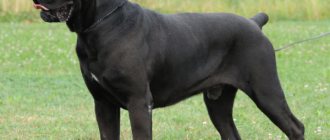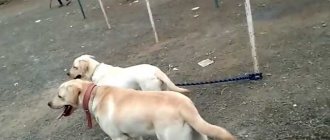Why do dogs have their tail docked - the history of the procedure
Many people do not understand why the tails of some dog breeds are cut off. But this tradition appeared a very long time ago. In ancient Rome, part of the tail was removed from dogs that herded livestock. It was believed that this would protect them from rabies.
Hunting dogs had their tails cut off to prevent them from getting hurt in the forest while chasing the beast. Often the tails of shepherd dogs were cut, as they guarded livestock and faced attacks from wolves.
If the tail was damaged in a fight, recovery was very painful and difficult.
Dog docking is a complex procedure that causes a lot of controversy.
In the 18th century in England there was a tax on dogs. To avoid it, the owners cut off the tails of their pets, since the owners of service dogs did not pay the tax, and a docked tail indicated that they belonged to a similar breed. This way the owners saved money.
Important! In most European countries today such operations are completely prohibited. They can only be carried out in case of medical indications. The only exceptions may be rescue or service dogs.
Trimming the tails and ears of animals began in ancient Rome.
Tail docking length
The length of the tail directly depends on the breed of the dog. Dobermans, Rottweilers and boxers are left with two vertebrae, while poodles, cocker spaniels, and Airedales are left with half a tail.
Why do you need ear cropping?
There are several reasons why dogs have their ears cropped. First of all, this decision is influenced by fashion and the usual appearance of dogs of a certain breed.
Can dogs have watermelon: are Yorkies, Spitz and other breeds allowed?
Working and hunting dogs have parts of their ears amputated for safety purposes. They often participate in fights and chases, and ear injuries can make their activities difficult. In most cases, ears are amputated without medical indications. Such animals are not allowed to participate in exhibitions or their points are deducted.
Note! Recently, many opponents of this procedure have appeared. In their opinion, this is cruelty to animals.
The ear cropping procedure is a very complex surgical operation associated with high risks. The animal has a long and painful recovery. In this regard, veterinarians recommend using docking only when the animal has severe damage to the ears that cannot be treated with conventional treatment.
Docking is recommended for guard and hunting dogs
Indications for surgery
Most often, dog owners cut off their ears in order to give their pet a scary appearance. But there are a number of medical indications for ear cropping. These include:
- mechanical damage and severe long-term non-healing wounds;
- burns;
- various necrosis;
- neoplasms.
Undocked Doberman with ears and tail
If there are no medical indications, but the owner is determined to carry out the procedure, it is recommended to first consult a veterinarian.
Important! In a number of countries, a dog is not allowed to be exhibited after docking.
Veterinarians' opinion
Why do dogs tilt their heads when they listen to their owner?
The American Veterinary Association comments negatively on the fashion for docking for aesthetic purposes. They are demanding to ban the practice of performing such a procedure as a cosmetic one. Experts rely on the fact that surgery and recovery are too painful for the animal.
Veterinarians are against performing an operation that causes great stress to the animal.
Why ACC supports cupping
The American Kennel Club remains a supporter of tail and ear docking. He identified 20 breeds for which ear cropping is indicated. These include Boston Terriers, Dobermans, and Boxers. Experts say that boxers often serve as guide dogs and guard dogs. Cropped ears help improve their hearing.
For many breeds, the reasons why dogs' ears and tails are docked have developed historically. For example, the Boston Griffon has always been designed to catch rodents. His ear was cut off to avoid injury from rodent attacks.
The opinion of dog handlers
Most dog handlers are convinced that this is the only way to preserve the characteristics of the breed. In addition, according to their arguments, surgery improves the dog's health.
More than 60 breeds, which include Rottweilers, Yorkshire terriers and cocker spaniels, traditionally have docked tails.
If the procedure is carried out immediately after birth, the puppy will not feel any pain at all, since its nervous system has not yet developed.
What breeds need this?
There are breeds for which ear cropping is considered a mandatory procedure. The list of which dogs have their ears trimmed includes:
- alabai;
- pit bull;
- Doberman;
- Caucasian Shepherd Dog.
At the request of the owner, the operation can be performed on a staff dog, cane corgi, miniature schnauzer, or boxer. Tail trimming is done on poodles, boxers, Rottweilers, Jack Russell Terriers, spaniels, and schnauzers.
Dobermanns have their tail docked to make them more aggressive
Cost, where can cupping be done
In all EU countries, docking is strictly prohibited. Operations here are carried out only illegally at home.
In Russia, docking can be done both at home and in specialized veterinary hospitals.
Due to the complexity of the operations and the difficult rehabilitation period, veterinarians do not recommend performing operations at home, as this can lead to serious complications for the dog.
The cost of the procedure for the ears is 500 rubles, cutting off the tail will cost from 2,000 to 4,000 rubles.*
Possible complications
Knowing why dogs' tails are docked, owners should also be aware of the possible consequences of the operation. A cut off dog tail can affect:
- communication of the dog with other animals. The tail refers to the organs that are the means of communication. The dog may no longer be accepted by other animals. They often treat bobtails aggressively because they cannot determine their behavior;
- development of diseases associated with joints. Due to the removal of part of the vertebrae, the load will be distributed unevenly. This can lead to the development of a hernia. In addition, due to the removal of part of the tail, deformation of the toes of the hind limbs may occur;
- manifestation of increased aggression. Experts have proven that dogs that have undergone docking are much more aggressive than other dogs;
- psyche - veterinarians say that removal of the tail, even at an early age, causes severe pain to the animal. The stress experienced subsequently affects the pet’s psyche;
- coordination of movements, development of motor skills. A dog's tail is not just a means of communication, but also a movement regulator. Cropped pets often skid when turning and are unable to maintain balance.
Ear trimming also does not leave a permanent mark on dogs. The procedure can lead to the development of infectious diseases. The ears become completely unprotected from dirt, water and dust, which can cause the development of serious diseases.
Tail cutting is a difficult procedure that can lead to a number of complications.
Is it possible to leave it undocked?
It is not uncommon now to find undocked breeds whose ears and tails were previously trimmed. For example, a Doberman will not look too angry and dangerous. If the dog does not have medical indications for docking, then surgery may not be performed. The exception is service dogs, for whom the procedure is indicated for safety reasons.
Pros and cons of cupping
The cupping procedure has its positive and negative sides. The advantages include:
- pleasant appearance of the pet in accordance with breed standards;
- advantage at exhibitions;
- hunting dogs are not injured while chasing an animal.
But this side also has very big disadvantages:
- the animal suffers after the operation, the recovery period is long and painful;
- in most countries, a docked animal will not be allowed into exhibitions at all;
- after relief, the risk of complications increases.
How does docking work on dogs?
Scientists conducted experiments on experimental rats, and it turned out that when we cut off the tail at a young age, we injure the nerve, and this has a bad effect on the dog’s sensitivity. They also claim that the animal's motor skills are reduced when such a procedure is performed. The tail is responsible for urination; if it is lost, the musculoskeletal system in dogs is disrupted, and urination diseases appear. Also, an abnormal location on the lower back and pelvis leads to weakening of the muscles, the development of intervertebral hernias, and distortion of the toes. It has been noticed that their relatives respond worse to dogs with docked tails than to animals with a normal tail. Experiments were carried out using a robot in the form of a dog. It has been noted that dogs approach a robot with a small tail less often and are more aggressive. It is believed that when there is no tail, this makes it difficult for animals to communicate with each other. Statistics have established that animals with cut tails are not inclined to communicate, are generally aggressive, and suffer from behavioral disorders.
In the first day after cupping, the dog may experience painful sensations, and to relieve them they are given antibiotics.
Although there is no scientific research on this problem, it can be established that tail amputation negatively affects the condition of the animal. Any owner must decide for himself whether it is worth cutting off such an important organ to his pet friend and subjecting his psyche to stress.
Why do dogs have their ears and tails docked?
Docking is a procedure for partially or completely removing a dog’s tail or ears. The operation is performed both for aesthetic purposes and for medical reasons.
The breed standards for some dogs require artificially docked body parts. But is this really necessary? Today, there is active debate about the need for this procedure.
Most European countries and many other countries of the world have long abandoned this procedure.
History of the procedure
You can’t even imagine how deeply the cupping procedure goes back to ancient times. On ancient Egyptian frescoes you can find an image of a black dog with cropped ears. She personifies the god of the dead, Anubis.
In 450 BC, the first documented case of docking a dog occurred in Ancient Greece. Alcibiades cut off the tail of his dog, which caused a violent reaction from the Athenians.
Lucius Columella wrote that ancient Roman shepherds cut the tails of dogs on the fortieth day of birth to avoid rabies. The ancient Greek traveler Pylos also noticed the docking of Roman dogs.
In 1763, in the German city of Weimar, a decree was issued on the imposition of taxes on peasant dogs. Boyar dogs were docked to distinguish them from peasant dogs.
In the 17th century, in England, all dogs except guard dogs were subject to taxes. To present their dog as a guard dog, people docked their tails.
Why dock your tail and ears?
Hunting breeds have their tails docked to reduce the risk of injury during hunting. For example, Jack Russell Terriers had their organ docked so that, if necessary, they could pull it and pull the dog out of the hole.
In ancient Rome, it was believed that a long tail gave an animal a greater chance of contracting rabies, so they were docked. And the ears of fighting dogs were cut off for more practical reasons. During the earlobe rupture, the animal lost too much blood. Well, if you don’t have ears, no problem. There is an opinion that after ear cropping, fighting dogs are better at picking up sounds.
Why does a dog need a tail?
Oddly enough, tailless dogs do not exist in nature. Animals whose organs have been cropped by humans still try to move them. Why are they doing that?
- Firstly, the tail is a way of communication. By its movements you can determine the mood of the animal. On a subconscious level, people have it in their heads: if a dog wags its tail cheerfully, it means it is friendly, and if it tucks under itself, it means it is scared. But don’t rush to draw conclusions. Dogs can also wave it in other situations.
- Traffic navigator. The organ helps the animal with excessively sudden movements, when moving on an uneven surface, while swimming.
- Method of odor transmission. At its base are the paraanal glands. The individual scent of the animal spreads if it is in an elevated position. When a dog waves its tail, it seems to show everyone its presence. When pressed, he tries to hide.
At what age do they dock?
In the first three days the tail is docked, and in the first 4 months the ears are docked. The tail is a continuation of the spine and consists of 15-23 vertebrae. Therefore, the operation is carried out during the first three days, when the newborn puppy has not yet formed strong bones. This is believed to be the least painful route for the dog.
After 3 days the operation can still be performed, but in this case anesthesia is used. The maximum permissible age for the operation is six months. Later it is very dangerous for the health of the animal.
Tail docking length
Depending on the breed, the tail is docked differently. It is believed that you cannot trim it too much, otherwise the puppy will suffer. Below is the table.
| Breed | Tail length after amputation |
| Boxer | 2-3 vertebrae (to cover the anus) |
| Doberman | 2-3 vertebrae (to cover the anus) |
| Toy Terrier | 2-3 vertebrae (to cover the anus) |
| Rottweiler | 1-2 vertebrae (to cover the anus) |
| Airedale | 1/3 of the previous length |
| Spaniel | 2/5-1/2 the same length |
| Wegner's pointer | 1/2 the same length |
| Kurzhaar | 1/2-3/5 of the previous length |
| Drathaar | 1/3-3/5 of the previous length |
| Poodle | 1/2-2/3 of the previous length |
What breeds of dogs are made
The ear cropping procedure is mandatory for:
- Doberman;
- Pitbull;
- Caucasian Shepherd Dog;
- Alabai.
At the owner's request:
- Staff;
- Cane Corso;
- Boxer;
- Miniature Schnauzer.
The following breeds have their tails trimmed:
There are a number of breeds that have natural bob tail. This:
Tail docking in an adult dog
If a dog's tail has not been cut within six months of birth, this cannot be done except for medical reasons. Such manipulations can have an extremely negative impact on the health of the animal.
To perform the operation after the 3rd day after birth, anesthesia is used. Adult dogs tolerate it very poorly, even to the point of death. In addition, the operation is very painful and can lead to many complications. So, if you want to dock an animal after six months only for aesthetic reasons, it’s better not to.
How does the operation take place?
Tail surgery occurs in two ways:
- The first, and least painful method involves removing the organ with surgical scissors within three days of the puppy’s birth. The operation does not require anesthesia and does not require stitches. Ideally carried out by veterinarians, but can also be carried out by breeders at home.
- The second method is to apply a special rubber band (ligature) to the tip of the tail. The ligature does not allow blood access to the tip, and after a few days it falls off on its own.
Here's how ear cropping works. Here, anesthesia is required for the dog, since the procedure itself is quite painful. You cannot feed the animal 12 hours before surgery.
The dog is fixed on the operating table after a dose of novocaine or antipsychotic is administered. Sometimes the operation is performed under general anesthesia. The circumcision process itself occurs using a scalpel.
After the cupping procedure, the wound is sutured and treated with antibacterial agents. The duration of the operation generally takes from 30 minutes to 1.5 hours.
Rehabilitation period
After docking the tail, monitor the puppy for several hours to avoid bleeding. Kutya heals quite quickly and without complications.
After ear surgery. To prevent the animal from scratching the seams, a special plastic frame is put on it. If the animal feels pain and constantly rushes about and whines, it is prescribed painkillers. Also spend a lot of time on the seams, they need to be constantly processed. For disinfection, use hydrogen peroxide, brilliant green, calendula tincture or streptocide.
The stitches are removed after a couple of weeks, but the rehabilitation period does not end there. If, after removing the stitches, they have healed correctly, ears will still need to be fitted for the owner and dog.
Possible complications
What a docked tail can theoretically affect:
- communication with animals and socialization. Since this organ is the dog’s means of communication, its removal may affect the perception of it by other animals. Relatives are more aggressive towards bob-tailed dogs, as they do not always correctly perceive their behavior and motives;
- increased aggression. It has been statistically proven that docked dogs are more aggressive than their relatives with healthy tails;
- joint problems. Due to improper distribution of the load on the hind limbs, the animal may develop a hernia in the future. Also, removal of the tail is fraught with the development of deformities of the fingers of the hind limbs;
- motor skills. The tail is not only a way of communication, but also an important regulator of the animal’s movements. Due to its absence, some problems with motor skills arise. Ordinary dogs do not skid as much when turning as docked dogs;
- psyche. Research shows that tail removal, even at an early age, is very painful for the puppy and the shock experienced can lead to mental problems in the future.
Up to what age and why do dogs’ ears and tail be cropped?
Cropping dogs' ears and shortening their tails are centuries-old traditions for some breeds. They have led to the fact that without these procedures the dog will not meet breed standards.
Currently, the requirements are being relaxed, so cropping both the dog’s ears and tail is becoming optional. But a purebred puppy that is promising for breeding must go through many exhibitions and receive permission to procreate.
If docking has not yet been canceled for a given breed, then it is necessary to take care of it as soon as possible.
Reasons for docking tails and ears
If now the majority of dogs are purchased simply out of love for the breed, then previously they had their own purpose. They served man, they were helpers. There were hunting dogs, sled dogs, shepherd dogs, and guard dogs. They performed their functions perfectly, but during the performance of some duties they could be injured.
In all types of hunting dogs, the “weak point” is the tail. In thickets in meadows and forests, in shallow water bodies, in a swamp, he could get injured on some plants, which often led to severe bleeding.
This distracted the dog from performing its duties, and the wound could become infected. In addition, it was believed that the tail slows down the dog's running, while in the absence of a tail the back muscles are strengthened.
In those days, docking the tail of a hunting dog was considered mandatory.
Why the ears and tails of other dog breeds are cropped is also easy to explain. Service dogs, especially guard and herding dogs, while performing their functions, came into battle with wild animals. They were fearless and did not notice pain in a fight. The result was torn ears and a damaged tail. For such breeds, it was decided to dock both the dog’s tail and ears.
For the same reason, it was mandatory to trim the tails and crop the ears of fighting breed dogs.
The length of the tail, as well as the shape of the ear, were at first involuntary, but then standards were adopted. They were designed so that the dog looked harmonious and did not appear ugly.
Recommended age for tail docking
The younger the animal is, the easier it will tolerate the procedure of cutting its tails and ears.
It is advisable to dock the tail of any dog when it is between three and ten days old. In small puppies, the wound heals quickly and bleeding is minimal. In many clinics, the procedure is performed without pain relief.
Whether dogs at this age feel pain or not is a controversial issue. Some puppies tolerate this procedure without a single squeak, while others whine for a long time after it. In any case, there are nerve endings in the tail, which, when injured, always send a signal to the brain. But everything is very individual: some puppies have a high pain threshold, while others have a low one.
If you are unsure whether your pet will experience pain or not, ask for local anesthesia. There are no side effects with it, and the puppy will be calm.
If at this age you did not have time to trim your tail, it can be done up to a month. It is undesirable to carry out such an operation at a later date, because the cartilage will ossify, the operation will be more complicated, stitches will have to be placed and general anesthesia will be required.
How does this happen
The procedure is simple and no special preparation is required. It does not last long and consists of several stages:
- a painkiller is administered, calculated according to the dog’s weight;
- the skin on the tail is moved as close as possible to its base. This is done necessarily, because after circumcision the skin will move into place and close the wound. If there is not enough skin, the stump will take a long time to heal, and hair will not grow at the end of the tail in the future;
- A bandage tourniquet is applied at the base to reduce bleeding;
- circumcision is carried out with scissors or a scalpel;
- the wound is treated with an antiseptic;
- the tourniquet is removed so that the skin moves into place, and then the tourniquet is tied again;
- for puppies after 10 days, a suture is placed at the end of the docked tail; younger puppies do not need to do this, the wound quickly heals on its own;
- the tourniquet is removed.
It is important to ensure that the mother does not lick the tails of her puppies for some time after the operation.
The threads are removed from the seam after 4-5 days, sometimes earlier.
When is ear circumcision performed?
When to crop ears depends on the breed of dog. Usually this is 2.5 or 3 months of age, but in some cases a dog’s ears can be cropped up to a year.
In small breeds of dogs, docking is carried out earlier; in large breeds, which have thick skin, the ears are formed later.
The timing is affected by the shape of the head and its changes with age. In small puppies, it is impossible to determine how the proportions of the head and ears will change after a month or two. Improper trimming can ruin the dog's entire appearance.
How to shape ears
It is necessary to prepare your pet for surgery in advance. You need to get all the necessary vaccinations and deworming. The pet must be healthy.
Optimal age
The optimal time for the procedure is 3-10 days after the birth of the puppy. The vertebrae are not yet ossified, the pain sensitivity threshold is lower than in older dogs. In such animals docking is carried out without anesthesia or suturing. Docked puppies are isolated from their mother for a while and are brought in only for feeding time.
Sometimes the operation is performed on puppies older than 10 days. In such cases, local or general anesthesia is needed.
Important! The older the puppy, the more painful the procedure is for him. Therefore, it is better not to subject your pet to torture if he is already 10 days old.
Why do dogs have their tails and ears docked and at what age is it best to do it?
In recent years, in many European countries, cynological societies and owners of tailed pets have increasingly begun to refuse the docking procedure. In some countries, this innovation is enshrined at the legislative level. There are also opponents of such changes in breed standards, who believe that this is necessary. Why do dogs have their tails and ears docked and is it really necessary?
History of the procedure
Tails and ears were docked mainly for dogs of various working breeds - hunting, herding, fighting. There is a version that we owe the appearance of the procedure to the ancient Romans.
Legionnaires who are fond of dog fighting and raised fighting dogs noticed that trauma to the soft part of the ears leads to large blood loss. Short ears, which had previously been injured in battle, did not differ in this unpleasant feature.
It was this observation that gave the Romans the idea of cropping the ears of their fighting dogs.
Tail docking has a slightly different story. The initiators of this procedure were the owners of hunting dog breeds.
Their pets were often injured during the rutting game, since the long tail became a vulnerable part of the body at the moment of a fight with a predator, but a docked one eliminated such problems.
For owners of burrowing dogs, the innovation has also become a convenient way to pull their pet out of the hole, using the rest of the tail as a handle.
Changing standards
Today, you can increasingly see unusual-looking dogs on the street - a Rottweiler and a spaniel with a tail, a Doberman with a tail and ears, a Staffordshire terrier that has lost its menacing appearance due to its cute floppy ears. More and more breeders and owners of pets of breeds that were previously subject to mandatory docking began to refuse the procedure.
The movement of animal rights activists to refuse docking began around the middle of the last century. Animal advocates say that the procedure has long lost its practical meaning and causes irreparable harm to health.
As a result, a number of European countries, such as Great Britain, France, Belgium, Holland, Germany, Switzerland, Austria, Czech Republic, Finland, Sweden, Denmark, Norway and Australia, legalized this ban.
True, there are some reservations regarding the country and date of birth of the animal, as well as operations performed for medical reasons.
The cynological unions of the listed countries have made changes to the breed standards. Only dogs that have been docked before a certain date or have a medical certificate confirming the need for the procedure are allowed for exhibitions.
In the Baltic countries there are a number of reservations about the origin and location of the operation.
In the countries of Eastern Europe, in particular in Russia, Serbia and Croatia, a similar law has not been adopted, and the operation remains at the discretion of the breeder or pet owner.
Advantages and disadvantages
Any action has its advantages and disadvantages. The cupping procedure is no exception. Supporters of tail and ear trimming actively convince of its benefits and even necessity. Most often this can be heard from owners of hunting and fighting dog breeds, such as:
- schnauzers;
- Great Dane;
- Doberman;
- Staffordshire Terrier;
- pit bull terrier;
- Caucasian Shepherd Dog.
These breeds most often have their ears trimmed, since the soft, drooping part contains many nerve endings and in case of injury or damage, the dog may experience severe pain, shock, and severe blood loss is also possible. It is also believed that cropped ears are less susceptible to infections and diseases than floppy ears.
Tails are cut:
- boxers;
- Rottweilers;
- Cane Corso;
- schnauzers (Zwerg, Mittel, Risen);
- Dobermans;
- Yorkshire terriers.
These are hunting and fighting breeds of dogs that are often injured during exercise by hitting hard objects. A short tail also helps the owner remove them from the hole and prevents injury from a predator.
The opponents' arguments are simple:
- the procedure has long lost its practical necessity for most breeds;
- this is intentional harm to the health of the dog;
- Circumcision disrupts the natural process of development of the puppy, inhibits growth, affects orientation in space, and deprives the opportunity to fully “communicate” with humans and relatives.
Everything that is given by nature is for a reason. Why a dog needs a tail can be read in more detail in this article.
When and why do dogs have their tails and ears docked?
Tails and ears are trimmed at different times. For each breed there is a certain time frame within which the operation must be performed. Thus, the tails of dogs of large breeds (Rottweiler, Doberman) are cut on the 2-3rd day after birth.
Schnauzers, spaniels and representatives of other medium breeds on the 4-5th day after birth. Babies' tails are cut at the age of 5-7 days. Such an early date for the operation is due to the fact that the vertebrae of the tail part of the body are still soft, cartilaginous.
Anesthesia at this age is strictly contraindicated for puppies, but the low pain threshold allows for relief without anesthesia, and wounds from the cut heal quickly and without problems.
Ear cropping is a more complex procedure. It is carried out at a later age, namely at 2-3 months. The main difficulty is to correctly determine the size of the ear, since the puppy is still growing and the proportions of the head and body are changing.
Docking is carried out according to the rules and in accordance with the requirements of breed standards. Previously, this was necessary for the dog to be recognized as a purebred and allowed to participate in exhibitions and breeding programs. Today, the operation in most cases remains at the discretion of the breeder.
How does the operation take place?
Cupping is carried out in a clinical setting by an experienced veterinarian. The length of the remaining tail must correspond to the standard of each specific breed. This can be 1-2 vertebrae or 1/3 of the tail.
Ears are cropped in a hospital setting using anesthesia. For each breed there are special patterns that determine the shape of the ears. After the operation, the puppy is given a special collar that prevents him from scratching his ears.
It is necessary to carefully monitor the condition of the seams. Ears can be placed, if necessary, on the second day after docking. Surgery at a later age threatens the formation of scars.
Before removing the stitches, the sutured ear must be massaged well to avoid “wrinkling” of the cut.











